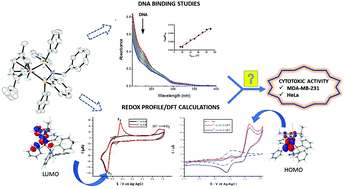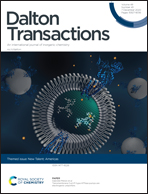Electrochemical, mechanistic, and DFT studies of amine derived diphosphines containing Ru(ii)–cymene complexes with potent in vitro cytotoxic activity against HeLa and triple-negative breast cancer cells MDA-MB-231†
Abstract
Complexes with general formula [RuCl(η6-p-cymene)(P–NR–P)]X (R = CH2Py (Py = pyridine) – [1a]+, CH2Ph (Ph = phenyl) – [1b]+, Ph – [1c] and p-tol (p-tol = p-tolyl) – [1d]+; X = PF6− or BF4−) were evaluated as cytotoxic agents against two cancer cell lines (HeLa and MDA-MB-231). All metal complexes are active in the range of concentrations tested (up to 100 μmol L−1). The IC50 (μmol L−1) values for the metal complexes are lower than that found for cisplatin. The activities are up to 6- and 15-fold higher than cisplatin for HeLa and MDA-MB-231 cancer cell lines, respectively. Studies of DNA binding and DNA cleavage were performed. DNA binding studies revealed a modest hypochromic shift in the metal complexes electronic spectra, indicating a weak interaction with Kb values in the range of 1.7 × 103–1.6 × 104. Although the cleavage tests revealed that in the dark DNA is not a biological target for these metal complexes, upon blue light irradiation they are activated causing DNA cleavage. Electrochemical studies showed the presence of two independent redox processes, one attributed to the oxidation process of Ru2+ → Ru3+ (EC process) and the other one to the reduction of Ru2+ → Ru1+, which is further reduced to Ru0 (ECE mechanism). In both processes, coupled chemical reactions were observed. DFT calculations were performed to support the electrochemical/chemical behavior of the complexes. The reactivity of complex [1b]BF4 with CH3CN was evaluated and two complexes were isolated [2b]BF4 and [3b]BF4. The complex mer-[RuCl(CH3CN)3(P–NCH2Ph–P)]BF4 ([2b]BF4) was isolated after refluxing the precursor [1b]BF4 in CH3CN. Isomerization of [2b]BF4 in CH3CN resulted in the formation of fac-[RuCl(CH3CN)3(P–NCH2Ph–P)]BF4. An attempt to isolate the fac-isomer by adding diethyl ether was unsuccessful, and the complex [3b]BF4 was observed as the major component. The complex [Ru2(μ-Cl3)(CH3CN)2(P–NCH2Ph–P)2]BF4 ([3b]BF4) proved to be very stable and can be obtained from both the mer- and the fac-isomers. The molecular structures of [1b]BF4 and [3b]BF4 were solved by single-crystal X-ray diffraction.

- This article is part of the themed collection: New Talent: Americas


 Please wait while we load your content...
Please wait while we load your content...